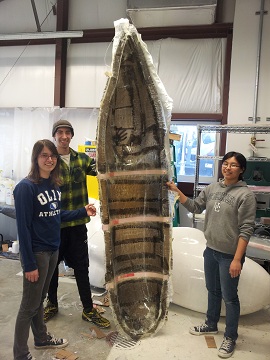Mold-Making and Door Design
March 13, 2013
The last couple of weeks have been flying by with the immense progress which has been made in the fairing manufacture process. We're currently done with about half of the mold and hope to have the full mold done by the end of this week.
Two weeks ago, two of our team members drove up to New Hampshire to visit new sponsor Soller Composites. Soller generously gave their time to help us understand what materials would be best for our vehicle and helped us procure the material. We came home from this visit with not only the carbon for the vehicle, a two-layer twill weave, but also thin fiberglass and a thicker fiberglass/basalt weave for the mold.
Once our male foam plug was fully assembled, spackled, and painted, we began moving forward with making our fiberglass molds. In preparation for this step, we considered our processes from last year and how we could improve them.
We first completed a practice lay-up with a new mold preparation technique, specifically, using packing tape, an idea adapted from Rose-Hulman's HPV team. The idea behind using packing tape on the molds is to prevent the dried epoxy from sticking to the mold, without using tedious mold preparation techniques, which have to be re-applied on each lay-up. We were pleased by the ease of release, but want to find a release method which doesn't leave noticeable lines on the composite surface. Other options discussed included Saran wrap and Pam.
Before constructing our molds, we put a lot of thought into how our riders would enter the vehicle. We’ve decided to have a hinged door on one side which swings upward and is permanently mounted to the vehicle. This one-sided door allows us to maintain the structural strength we want in the monocoque fairing, reduce weight, and allow decent rider accessibility. We believe we can eliminate the safety concerns of having only one door (i.e. what if you fall over on that one door and get trapped inside) by using hinges with removable pins. We're planning on putting the door on the right hand side as historical evidence has implied that the vehicle most often crashes onto its left side. We intend to manufacture the door using a stand-alone mold taken from the male foam plug.
We decided that we will be using a three-part fiberglass mold instead of the four-part design we used last year. We first built a door mold over the lines we drew on the plug. Then, we laid up the mold for the top half of the vehicle. Last night, we moved on to the next section and did the bottom left side. The final section, the bottom right side, will be completed this week. We're constructing each of our molds with a layer of fine fiberglass covered with layers of chopped fiberglass mat and the thick fiberglass/basalt weave. We have inserted foam ribs under the outer layers for stiffness.
Next week is Olin’s spring break, at the end of which the ASME HPVC Design Report is due. This has decided the spring break plans for some of our team members :). We won’t be devoting our lives to the design report, but it will definitely get done next week. Our other plans for spring break include finishing the drivetrain design and performing the main carbon fiber layups for the fairing. Competition is six weeks away, but we think we’re in a great place right now and are proud of our progress.


